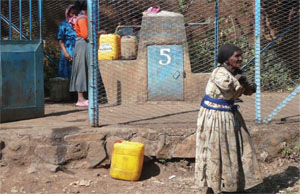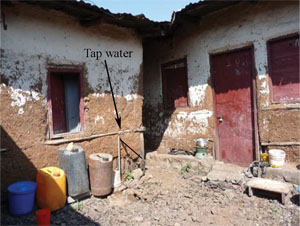13.4.3 Physically accessible
Water must be within safe physical reach, in or near the house, school or health facility. Accessibility to safe water can be classified as follows:
No access. You would say people do not have access to safe water when:
- The distance to the water source is more than one kilometre or more than a 30-minute round trip.
- The amount of water collected is very low (often below 5 litres per capita per day).
Basic access (see Figure 13.5). You would say people have a basic level of access to safe water when:
- The water source is within one kilometre/30-minute round trip.
- The amount of water to be collected on average is unlikely to exceed 20 litres per capita per day.

Intermediate access (see Figure 13.6). You would say people have an intermediate level of access to safe water when:
- Water is provided onsite through at least one tap (at yard level).
- Average volume of water collected is approximately 50 litres per capita per day.

Optimal access. You would say people have optimal access to safe water when:
- Supply of water is through multiple taps within the house.
- Approximately 100–200 litres per capita per day or more is available.
Earlier in this session it was said that the daily minimum water requirement was between 2 and 4.5 litres per person per day according to climate conditions. Why does this differ from any of the average consumption figures quoted above?
Because the average consumption refers to water used for all household purposes including washing, cooking and cleaning as well as drinking and eating. The requirement of 2 to 4.5 litres per person per day is the volume of water that must be consumed by a person to survive.
13.4.2 Safe and acceptable
